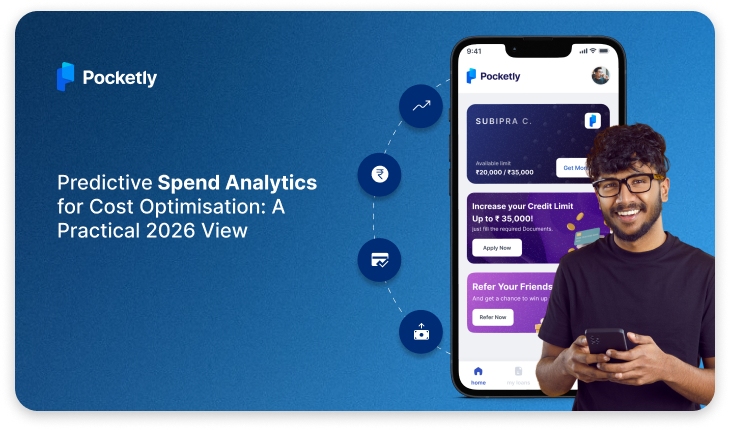
Have you ever wondered what happens when you miss a loan EMI or delay a payment? Banks don’t immediately flag your account as a Non-Performing Asset (NPA); instead, they categorise it under a Special Mention Account (SMA). This system is designed to detect early signs of financial stress and prevent defaults before they escalate.
A Special Mention Account (SMA) is a classification used by banks to monitor accounts that show repayment irregularities. It’s a warning system, allowing both borrowers and lenders to address financial concerns early on. This classification can directly impact your CIBIL report, affecting your creditworthiness and loan eligibility. Understanding SMA categories and their implications can help you manage your finances better and avoid long-term credit issues.
In this blog, we’ll break down what SMA is, how it affects your credit score, and the steps you can take to prevent your account from falling into this category. Whether you’re a borrower trying to stay on top of your payments or someone curious about the banking system, this guide is here to simplify everything for you.
What is a Special Mention Account (SMA)?
A Special Mention Account (SMA) is a category used by banks to flag accounts showing early signs of financial stress. It acts as an early warning system for lenders, helping them identify potential repayment risks before they escalate into Non-Performing Assets (NPAs).
- Definition: SMA accounts are flagged when a borrower shows irregularities in repayments or other financial stress indicators.
- Purpose: It allows banks to take proactive steps to address these issues, ensuring better loan management and minimising defaults.
Think of it as a heads-up system for both you and the lender, giving you a chance to set things right before things spiral out of control.
Importance of Special Mention Account in CIBIL
A Special Mention Account (SMA) serves as an early warning system for repayment irregularities. It helps borrowers address overdue payments before they escalate and allows lenders to take corrective actions, protecting both credit scores and financial stability.
Key Points Highlighting the Importance of SMA:
- Early Warning for Borrowers: Borrowers can act on overdue payments promptly, reducing the risk of severe financial consequences.
- Impact on CIBIL Score: SMA classifications can lead to credit score drops if not addressed, affecting future credit eligibility.
- Enhanced Transparency: Banks and borrowers gain a clear picture of repayment irregularities, fostering accountability.
- Loan Recovery Strategy: Lenders use SMA data to implement proactive recovery measures, offering borrowers opportunities for restructuring.
- Reduced Risk of NPA: Early identification and resolution of SMA status prevent loans from escalating to NPA status, protecting borrowers' creditworthiness.
- Improved Borrowing Potential: Proactively addressing SMA issues can safeguard credit profiles, enabling smoother loan approvals in the future.
Understanding and managing your SMA status helps maintain your financial health and ensures that your CIBIL report reflects a positive borrowing profile.
Categories of Special Mention Accounts (SMA)
When it comes to identifying financial stress in loan accounts, banks use a structured approach by categorising Special Mention Accounts (SMAs) based on the severity of overdue payments. These categories act as early warning signals, helping both lenders and borrowers address issues before they escalate into bigger problems.
1. SMA-0: Payments Overdue for 1–30 Days
This is the first red flag that signals a potential repayment issue. If your EMI or payment is overdue for even a day within this range, your account may fall under SMA-0. At this stage, it’s not yet a critical concern, but it’s a prompt to ensure you don’t miss future payments.
Example: You might have missed an EMI due to a cash flow mismatch or an oversight. Resolving it quickly can prevent further escalation.
2. SMA-1: Payments Overdue for 31–60 Days
As payments remain overdue for over a month, the account moves into the SMA-1 category. At this stage, the risk of the account turning problematic increases significantly. Lenders may start taking proactive steps, such as reminders or calls, to nudge borrowers toward repayment.
Example: You might be facing temporary financial difficulties. Lenders could offer options like extending deadlines or partial payments to avoid further stress.
3. SMA-2: Payments Overdue for 61–90 Days
This is the final stage before an account is classified as a Non-Performing Asset (NPA). With payments overdue for two to three months, the borrower is seen as highly likely to default. At this point, lenders might engage recovery agents or initiate legal notices to safeguard their interests.
Example: Continuous delays due to financial instability can push the account to the brink of becoming an NPA, which could severely damage your credit profile.
4. SMA-NF: Non-Financial Indicators of Stress
SMA-NF accounts are flagged based on non-financial issues rather than overdue payments. These could include operational challenges, legal disputes, or any other red flags that suggest potential stress in the borrower’s financial stability.
Example: A business facing operational disruptions might still be making timely payments, but lenders could categorise it as SMA-NF if they detect signs of future financial trouble.
Why These Categories Matter
Each category provides lenders with insights into your repayment behaviour and the likelihood of default. While SMA-0 serves as an early warning, SMA-1 and SMA-2 indicate progressively higher risks. Even non-financial factors in SMA-NF can impact how banks view your creditworthiness.
Being aware of these classifications empowers borrowers to take corrective measures early on, avoiding severe repercussions like a drop in their CIBIL score or limited access to credit in the future.
Role of SMA in Credit Assessment
A Special Mention Account (SMA) doesn’t just signal a warning to your lender—it also carries implications for your financial reputation and borrowing future. Here’s how:
- Credit Score Impact: Being flagged under an SMA category is a red flag for credit bureaus. Missed payments or overdue amounts reported as SMA can cause your CIBIL score to drop significantly. Frequent SMA entries signal poor financial discipline, making it harder to maintain a healthy credit profile.
- Loan Approvals: Banks and lenders are cautious about extending loans to borrowers with SMA accounts. These accounts indicate potential repayment risks, so even if you manage to get a loan approved, you’re likely to face higher interest rates and stricter terms.
- Indicators of Credit Risks: An SMA tag acts as a warning signal to lenders that your financial situation might be shaky. This can lead to hesitation or outright refusal when you seek new loans, as lenders assess you as a high-risk borrower.
Impact of SMA on Credit Score and Loan Approval
The effects of being flagged as an SMA go beyond immediate concerns—they can shape your financial future. Let’s look deeper:
- Credit Score Drop: When payments are overdue and reported under SMA categories, the information is shared with credit bureaus like CIBIL. This can result in a noticeable decline in your credit score, reducing your creditworthiness in the eyes of lenders.
- Higher Interest Rates: Borrowers flagged with SMA entries are seen as risky, leading lenders to compensate by charging higher interest rates. This can make borrowing significantly more expensive in the long term.
- Reduced Borrowing Capacity: A low credit score combined with an SMA record means fewer borrowing options. Lenders may reject your application outright, or you might only qualify for smaller loan amounts with unfavourable repayment terms.
Suggested read: Understanding Line of Credit: Definition, Types and How it Works
Identifying and Verifying SMA Status
Staying informed about your SMA status is critical to preventing further financial complications. Here are some easy ways to monitor your account:
- Monitor Bank Communication: Pay close attention to emails, SMS alerts, or letters from your bank. These communications often highlight overdue payments or account changes.
- Review Statements: Regularly check your bank or loan account statements for any mention of overdue amounts or SMA classification. This habit can help you catch problems early.
- Online Banking Tools: Many banks now offer detailed account tracking through their online platforms. Log in to your Internet banking portal to check for overdue payments or SMA tags.
- Contact Customer Service: When in doubt, contact your bank’s customer service team. A quick phone call or branch visit can clarify your account status and provide the next steps.
Managing and Mitigating SMA Status
If your account has been flagged as SMA, it’s not the end of the world. Taking proactive measures can help you regain financial stability and avoid further consequences:
- Timely Repayments: The most effective way to improve your status is by paying off overdue amounts as quickly as possible. Consider setting up automatic payments or alerts to ensure you never miss a due date again.
- Communicate with Lenders: If you’re facing genuine financial difficulties, don’t hesitate to talk to your lender. Most banks are willing to discuss alternatives like restructuring your loan or extending your repayment period.
- Plan Finances Proactively: Review your budget and prioritise loan repayments above discretionary spending. Cutting down on non-essential expenses can free up funds to meet your EMI obligations.
Taking these steps not only helps you manage your SMA status but also prevents the situation from escalating to an NPA (Non-Performing Asset).
Early intervention and open communication with your lender can go a long way in protecting your financial health and maintaining your creditworthiness.
SMA & NPA: What Do They Mean?
When it comes to understanding your financial health, the terms Special Mention Account (SMA) and Non-Performing Asset (NPA) often come up. While both relate to loan repayment issues, they serve different purposes in identifying and addressing financial distress.
- SMA (Special Mention Account):
- This is an early warning system used by banks to track accounts showing initial signs of repayment stress. SMAs categorise overdue accounts into:
- SMA-0: Overdue by 1-30 days.
- SMA-1: Overdue by 31-60 days.
- SMA-2: Overdue by 61-90 days.
- NPA (Non-Performing Asset):
- Once a loan account is overdue by more than 90 days, it is classified as an NPA. This indicates a significant default, and the lender may initiate recovery or legal measures.
SMA vs NPA: Which One is Better for Financial Health?
When it comes to managing loans and credit, understanding the difference between Special Mention Accounts (SMA) and Non-Performing Assets (NPA) is crucial. While neither is ideal, SMA serves as an early warning system, giving borrowers a chance to correct their repayment behaviour before things escalate.
Let’s break it down in a simple comparison table:
| Aspect | SMA (Special Mention Account) | NPA (Non-Performing Asset) |
|---|---|---|
| Definition | Early warning system for accounts showing repayment stress. | Indicates loans overdue for more than 90 days, reflecting default. |
| Stage of Distress | Initial signs of repayment challenges. | Significant repayment failure and default. |
| Overdue Period | - SMA-0: 1-30 days overdue - SMA-1: 31-60 days overdue - SMA-2: 61-90 days overdue
| Overdue for more than 90 days. |
| Impact on Borrower | Provides an opportunity to resolve issues without severe credit impact. | Major credit score damage, reducing future borrowing potential. |
| Lender Actions | May offer restructuring, reminders, or alternative repayment plans. | Initiates recovery actions, including legal measures or asset seizure. |
| Credit Bureau Reporting | It may not immediately affect credit reports but can lead to score drops if unresolved. | Reported to credit bureaus, significantly harming the borrower's credit profile. |
This table highlights the importance of addressing SMA classifications early to prevent escalation to an NPA, ensuring better financial health and easier loan management.
Why is SMA Preferable Over NPA?
If your account is flagged as SMA, it’s a sign to act immediately. While it indicates a risk, you’re still able to turn things around by making repayments or negotiating with your lender. On the other hand, NPA represents a complete default, making it much harder to restore your financial credibility.
In short, SMA is a wake-up call, while NPA is the consequence of ignoring that call. Staying proactive when flagged as SMA can save you from the long-term impact of being listed as an NPA.
Thinking about getting a loan but worried about your credit score? Don’t stress, Pocketly has your back! With quick approvals, flexible terms, and minimal credit requirements, Pocketly makes borrowing simple, even if your credit score isn’t perfect.
Let’s see how Pocketly can be your go-to financial partner!
Pocketly: Your Go-To Loan Partner
When unexpected expenses pop up, you need a lending platform that’s fast, transparent, and easy to use. Pocketly ticks all those boxes, making it the perfect choice for students, young professionals, or anyone in need of a quick loan.
What Sets Pocketly Apart?
- Low Credit Score? No Problem!
- Pocketly’s approval process doesn’t hinge on a high credit score, making it accessible for those with less-than-perfect credit.
- Lightning-Fast Approvals
- Apply through the app and get your loan approved in minutes. Emergencies can’t wait, and with Pocketly, neither will you.
- Transparent Fee Structure
- No hidden surprises—Pocketly keeps everything clear and upfront so you know exactly what you’re paying.
- Custom Loan Amounts
- Need ₹1,000 or ₹25,000? Choose the amount that fits your situation and repay on terms that suit you.
- Eligibility for 18+
- Whether you’re a student or a young professional, Pocketly is open to anyone 18 years and above and you get the loan in snapping minutes!
- Convenient App Features
- Manage your loan applications, track payments, and access customer support—all from a user-friendly app designed for simplicity.
Pocketly isn’t just a lender; it’s your financial ally in times of need. Whether it’s an unexpected bill or a planned expense, Pocketly offers the support you need with a process designed to be simple, fast, and stress-free.
If you want to apply for an instant personal loan with Pocklety, learn more in detail with our guide, Getting Personal Loan without CIBIL and Income Proof Online.
Conclusion
Understanding the concept of Special Mention Accounts (SMAs) is essential for managing your financial health and safeguarding your creditworthiness. An SMA status isn’t the end of the road—it’s an opportunity to address repayment issues early and prevent your account from turning into a Non-Performing Asset (NPA). By staying informed, maintaining regular communication with your lender, and prioritising timely repayments, you can turn financial challenges into manageable situations.
If you ever need quick financial assistance, platforms like Pocketly can help bridge the gap without overwhelming stress. With their simple application process and borrower-friendly features, you can regain control over your finances quickly and confidently.
Take the first step and download the Pocketly app today!
FAQs
What is an SMA in banking?
An SMA, or Special Mention Account, is a classification for accounts showing early signs of financial stress due to delayed repayments.
Does having an SMA status affect my credit score?
Yes, an SMA classification can negatively impact your credit score as it reflects repayment irregularities.
How can I avoid SMA classification?
You can avoid SMA status by making timely payments, monitoring your loan accounts, and communicating with your lender if repayment issues arise.
What happens if my account moves from SMA to NPA?
If your account becomes an NPA, it indicates a default beyond 90 days, which severely impacts your credit score and limits your borrowing options.
Can I get a loan from Pocketly if my credit score is low?
Yes, Pocketly focuses on your current financial stability rather than just your credit score.
How quickly can I receive funds from Pocketly?
Pocketly ensures quick disbursal, often within minutes of loan approval.
What loan amounts are available through Pocketly?
Pocketly offers flexible loan amounts ranging from ₹1,000 to ₹25,000 to meet your immediate financial needs.















